Maintenance
The Maintenance module enables the registration of serviced equipment, for which it is necessary to clearly plan service interventions, inspections or legislation of the given inspection. It is a complex tool for managing your own and other people's devices, which may or may not be in the use of your own company.
The Maintenance module is divided as follows: Serviced Equipment is used for the registration itself, and the Service Requests book is intended for the collection and registration of service and maintenance requests, on the basis of which a document on a planned operation can be created in the Planned Service Operations book.
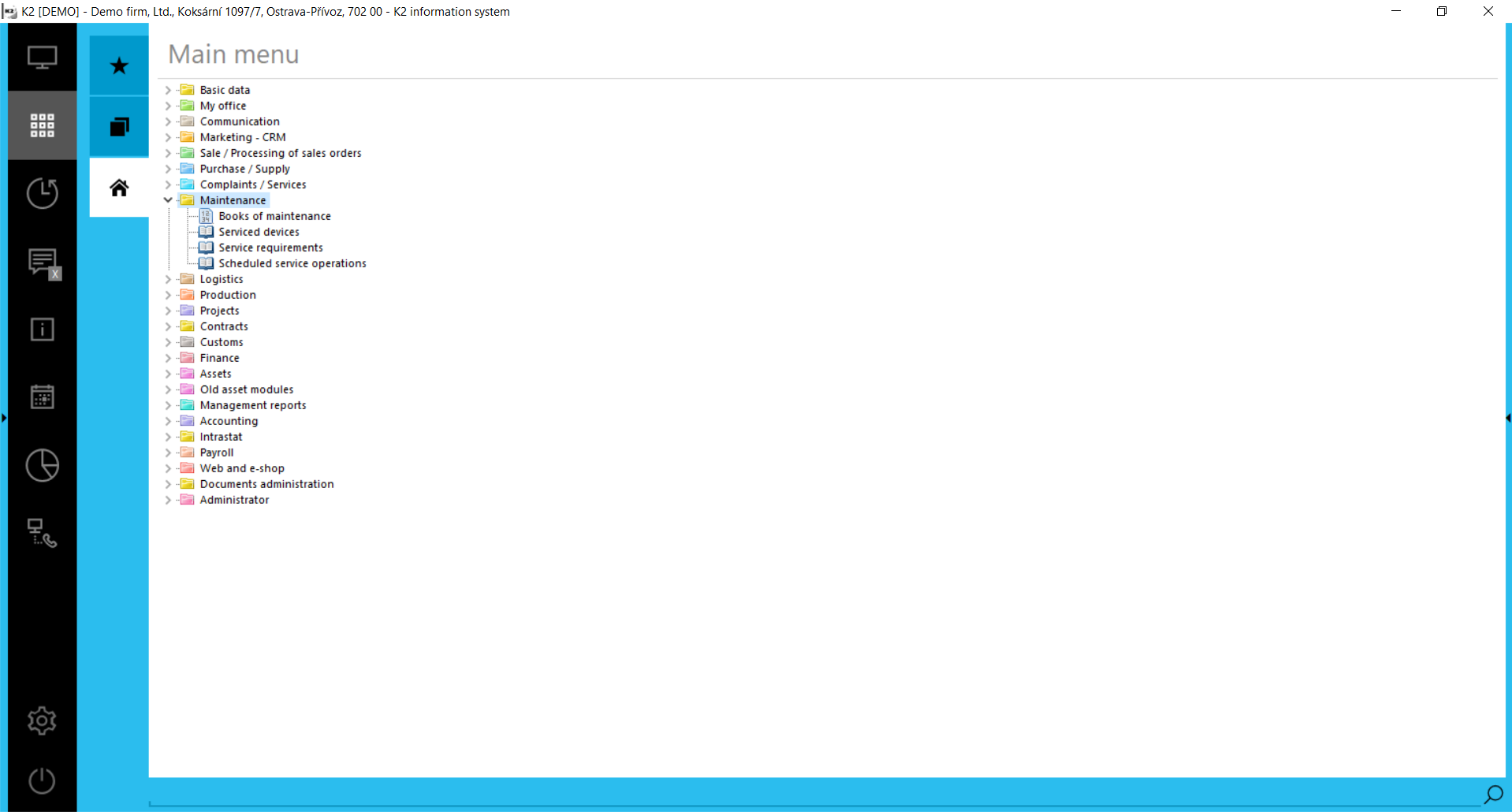
Picture: Maintenance module
Under the term serviced equipment we can imagine:
- a unit outside the company that our company manages for money
- equipment that provides service (spare parts, repairs, adjustments, registration of parameters).
- equipment that has been manufactured or sold in-house or is only a contracted service organization.
- an object that is intended for service in our company - we have its continuous registration (eg: car, tamping equipment, plasterer)
- our own machine / source K2 (does not decide whether it is owned). Our maintenance department has records of the repair plan and maintenance costs.
- asset card - eg: building, air conditioning, tangible property that needs periodic inspections and approvals (actions for which it is necessary to order subcontractors, certification authorities for "service")
- meter for which I deal with metrology (inspections, certification and registration of measured values)
Basic settings
The Maintenance module requires the setting of a default book for creating individual documents. In book management, it is therefore necessary to make basic settings and set rules for creating individual documents.

Picture: Settings of Maintenance book
Service card is used to create job cards, it is possible to use a predefined routings on this card. Furthermore, article card is selected, which has assigned routings for entering specific maintenance operations. The required field is also a type of job card, usually planning.
Creation options
Due to the interconnection of maintenance modules with other modules (Article, Resources, Assets and Orders), it is possible to create serviced devices within the mentioned modules.
Above the Article, Resources, and Assets book, there is a section in the ribbon on the Functions tab called Maintenance, which contains 3 basic commands that allow you to create:
New serviced device - this command can be run above the book, which will display the already pre-filled header of the serviced device. Just fill in the additional information and save the record manually (F2).
New service request - above the basic data it is necessary to become a ruler over a specific service facility. The order again creates a new Service Request, with pre-filled data, the document must be saved manually (F2).
New planned service operation - above the basic data it is necessary to become a ruler over a specific service facility. The order again creates a new Scheduled Service Action, with pre-filled data, the document must be saved manually (F2).
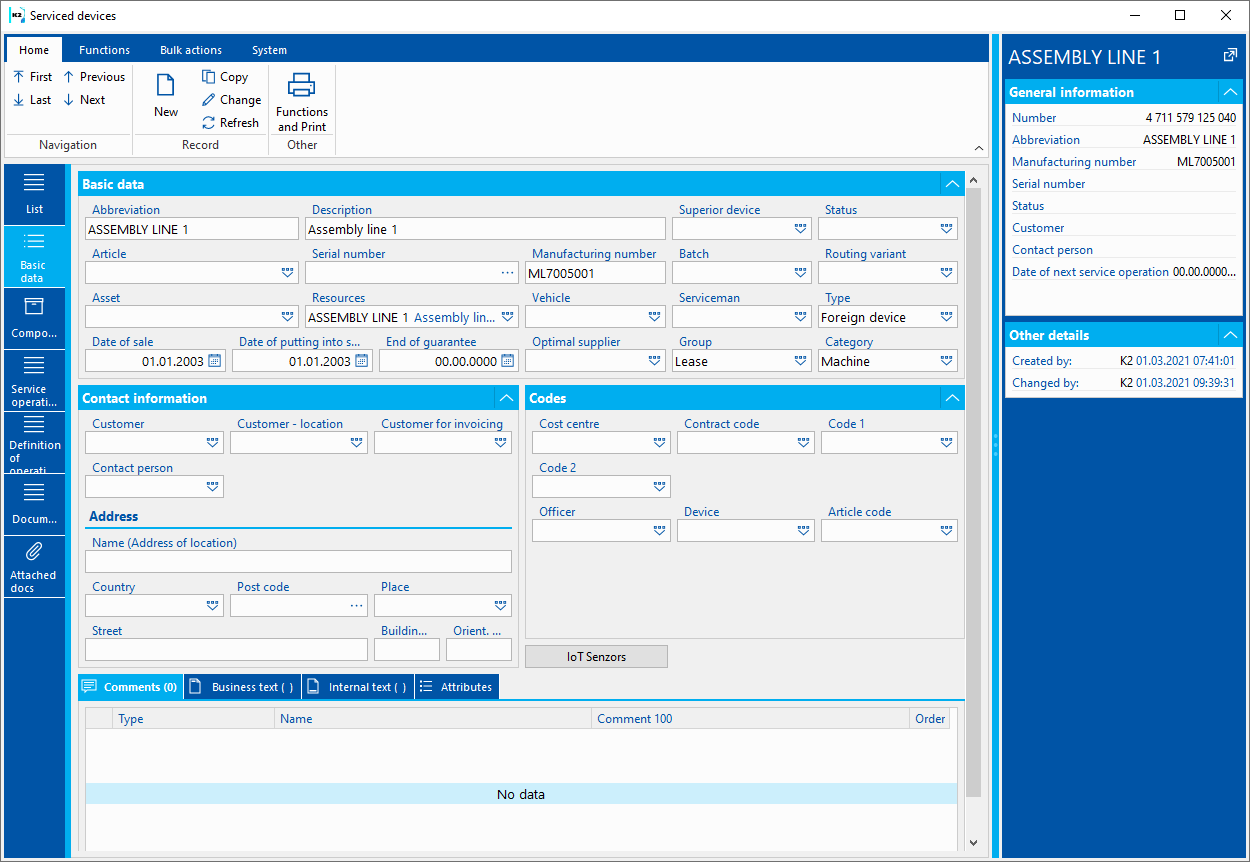
Picture: Maintenance section in ribbon
A scheduled service action can also be created on top of a specific service request in the Service Requests book. The command New scheduled service action is available in the ribbon - this will display the window of the new service action with pre-filled data.
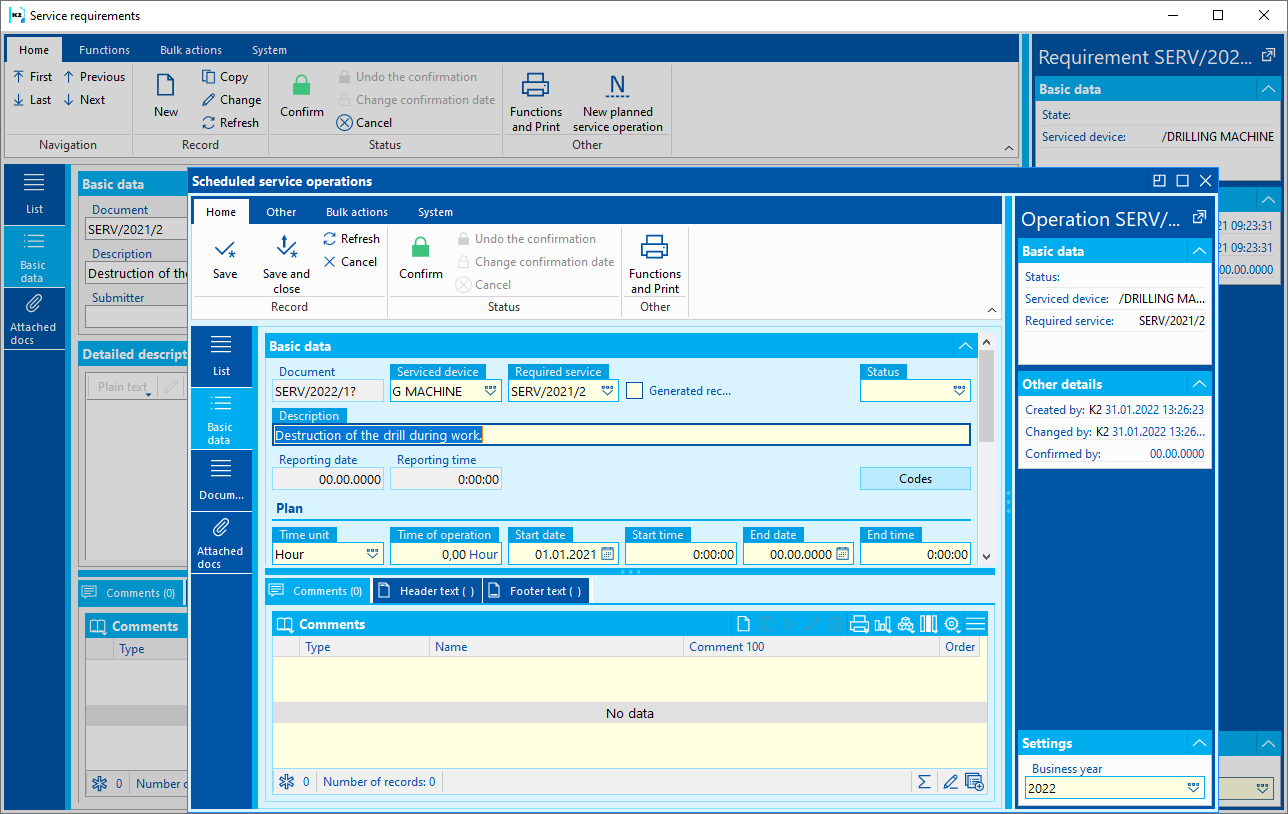
Picture: Option to create a new scheduled service action from the service request
A serviced device can be created over a specific sales item. The form in the ribbon will display the form for creating a new serviced device. K2 automatically completes the selected data from the sales item (abbreviation, name, batch, supplier, serial number).
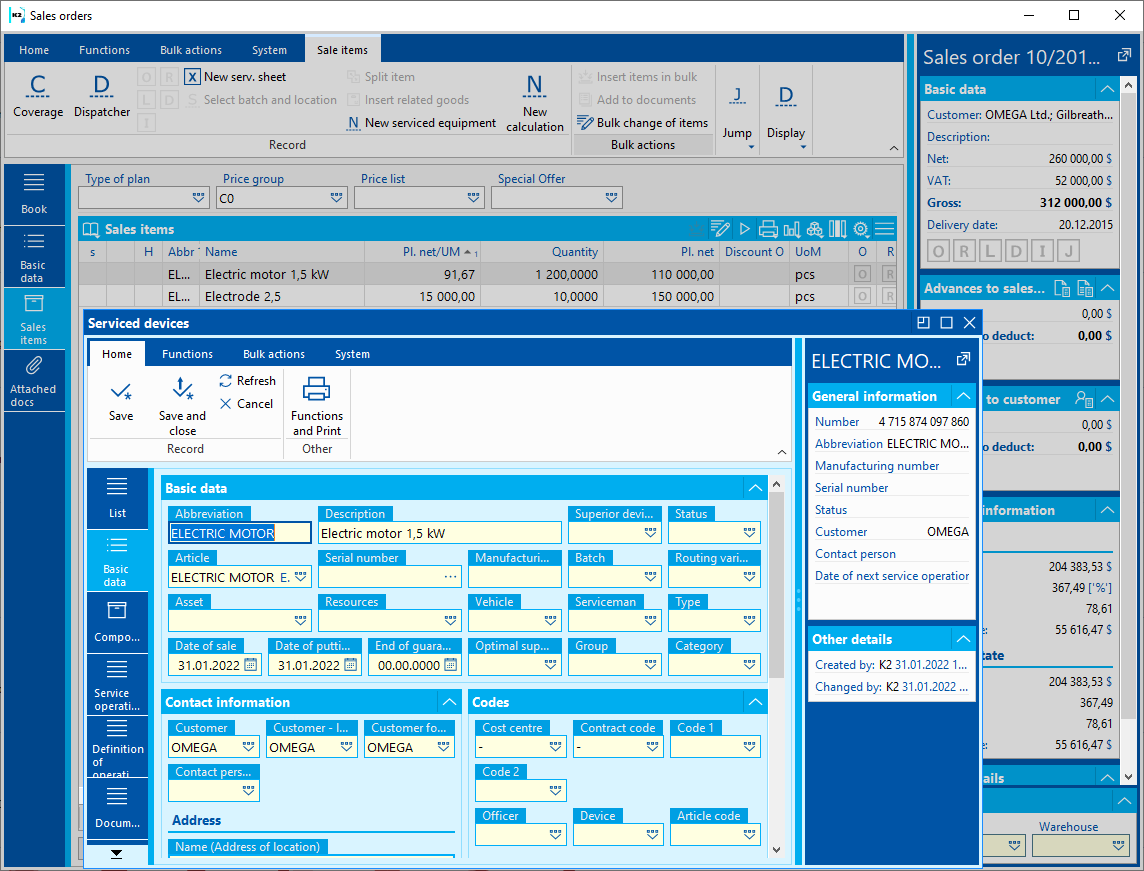
Picture: Creating a new serviced device from a sales item
Serviced equipments
Basic book for registration of all devices.
Pict.: Serviced equipments book
Basic data (1st page) - Serviced equipments
It is used to record general information about the equipment, You can select specific Article, Asset, Vehicle or even machines and other equipment from the Source code list. It is possible to create a new serviced device, which may not be linked to other modules, the only required field is the Device Abbreviation.
There are free code lists (Status, Type, Group and Category) that can be predefined and used as needed.
Below the basic data is located the Superior device field - it can be used for separate parts of more complex devices, which you also have in the register of serviced devices.
Picture Basic data of serviced equipment
Fields' description:
Abbr |
Unique designation of the selected device. |
Description |
Language name/ equipment description |
Superior equipment |
If it is a subordinate component, the superior device is filled in. |
Status |
Status of a document. The field can be filled in by a value from the user-defined code list. |
Articles |
Selection of article from a code list. |
Serial Number |
Selection from the Code list of serial number for selected article card. |
Production No. |
Production No. |
Batch |
Selection from the batch code list for selected article card. |
R variant |
Routing variant from selected article card. |
Assets |
Book of assets |
Resources |
Resource code list |
Vehicle |
Vehicles code list |
Service worker |
Person responsible for the equipment |
Type |
Optional code list, the field can be filled with a value from a user-defined code list. |
Date of sale |
Date when the device was purchased / sold. |
Commissioning date |
Commissioning date |
End of warranty |
End of warranty |
.Group |
Optional code list, the field can be filled with a value from a user-defined code list. |
Category |
Optional code list, the field can be filled with a value from a user-defined code list. |
There is also a section that concerns the customer, in this section it is possible, for example, to record the current location of the device.
Form contains analytical part - Codes.
Comments, business and internal text is also available, used to store notes. In addition, there is an option to assign a default set of attributes to the Basic Data.
Components (2. page) - Serviced equipments
For a device, it is possible to register its key components, of which it consists, including the serial and serial number of the given component. It is not necessary to register the components on the article cards, therefore it is possible to list various unregistered items among the components. The tree structure allows a clearer view of the subordinate and superior components.

Picture: Components
Components can be discarded or replaced with another, provided that the history of these actions is monitored. You can also use the copy command to copy components.
We insert a new component classically via Insert, or using the buttons in the context tab in the ribbon, called Components, and in case the components need to be replaced, the "Replace component" button will be used. This command discards the component and adds a new one.

Picture: Replace component
The component insertion form looks the same, only without the ability to select the previous component.
Service operations (3. page) - Serviced equipments
Service operations are captured in a table or in a tree structure - they can be set using the button in the ribbon in the context tab Service actions.
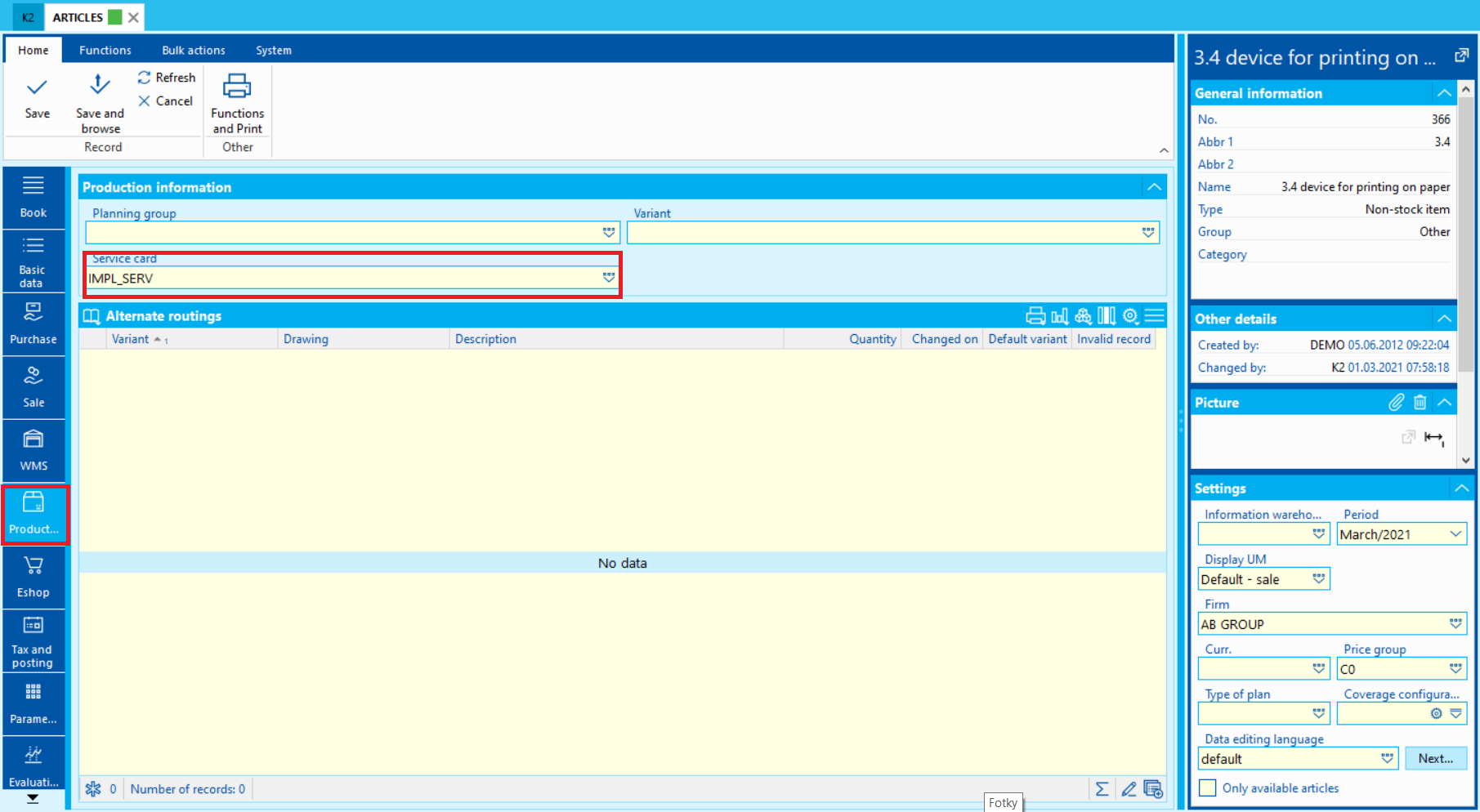
Picture: Tree structure and options for adding documents
The following documents can be created on this page:
- Service requests
- Scheduled service tasks
- Contracts for the purpose of selling their own services or complaints.
- Orders to provide service or order parts.
- Job cards are designed for service or maintenance in-house. For job cards, it is possible to predefine the procedure for the performed tasks of a specific machine. Using the definition of the article card with the variable R (Articles / Production / Service card), the general article card for creating service job cards can be set in the book, see. The basic settings, but the data filled in on the article card will take precedence during creation.
- Activities to capture the interventions of your employees on the facility.
- Transfer notes are intended for recording the transfer of the given device.
Task definition (4. page) - Serviced equipments
The definition of scheduled service actions is used for the bulk generation of scheduled actions that you are able to define and schedule once. For bulk creation according to definitions, just enter when you want to schedule planned service tasks. The maximum number of created actions will not exceed the value you selected, and if you select a number higher than the one in the definition, the value from the definition will take precedence. Scheduled service actions are created in the maximum number of repetitions entered in the definition, the same applies after entering the value 0.
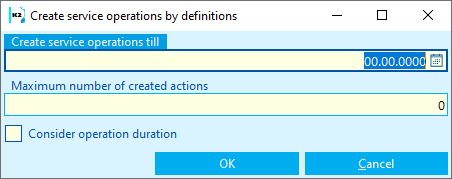
Picture: Creating service tasks according to definitions
You can create service tasks:
1) above the marked definitions on a specific device (Context tab Definition of actions / Create service actions according to definitions)
2) according to all definitions above the marked devices (Bulk actions / Create service actions according to device definitions)
Definitions can be created simply using a form, where it is necessary to fill in the rules for generating actions.
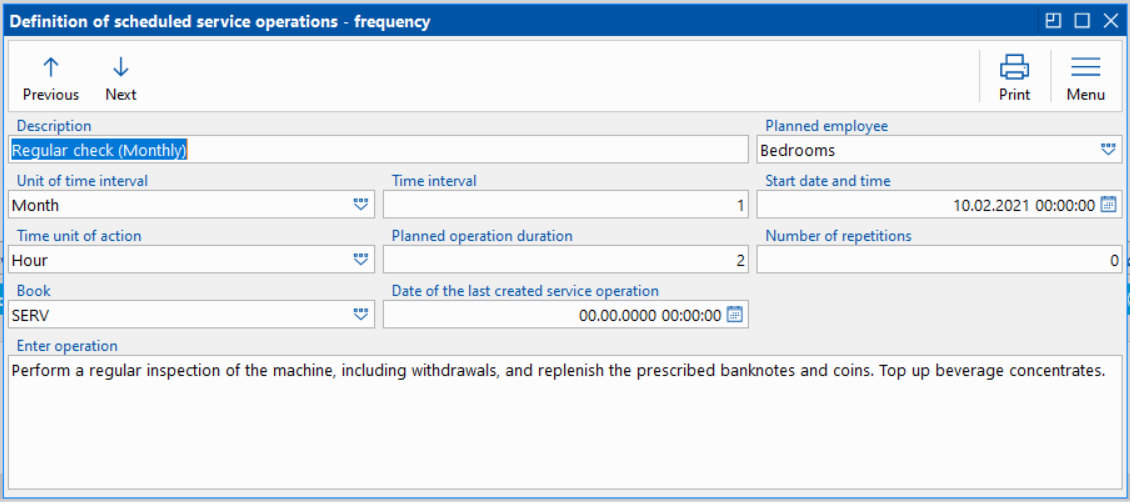
Picture: Definition of scheduled service actions
Fields' description:
Task definition template |
Selection from the code lists of predefined templates - aut. adds values from the template. |
Book |
The book in which the selected actions will be generated. |
Definition description |
Short description of service action |
Planned employee |
An employee who ensures that the task is completed. |
Unit of time interval. |
Specifies in what time unit the actions will be generated |
Time interval |
Time interval for repetition of the task |
Date and time of beginning |
Date and time of the start of the first scheduled service operation. |
Time unit of the action time |
Specifies in which time unit the time length of the action will be defined. |
Scheduled action time |
Scheduled action time in the selected time unit. |
Number of repetition |
The maximum number of created scheduled serviced actions. |
Date of the last created service operation |
Date of the last created service operation. |
Task assignment |
Detailed description / task assignment |
Attributes sets |
Attributes sets for selected service action. |
Employees |
Assigned employees table - more employees can be planned. |
Task definition template
The book is intended for storing individual service definition templates. The user is obliged to enter important general data into the template to create a new scheduled service operation using a definition. The filled in data is filled in the definition of the planned service action when selecting the template.

Picture: Task definition template
Fields' description:
Abbr |
Template abbreviation |
Book |
The book in which the selected actions will be generated. |
Definition description |
Short description of service action |
Unit of time interval. |
Specifies in what time unit the actions will be generated |
Time interval |
Time interval for repetition of the task |
Time unit of the action time |
Specifies in which time unit the time length of the action will be defined. |
Scheduled action time |
Scheduled action time in the selected time unit. |
Number of repetition |
The maximum number of created scheduled serviced actions. |
Task assignment |
Detailed description / task assignment |
Attributes sets |
Attributes sets for selected service action. |
Documents (5th page) - Serviced equipments
It is a summary of individual documents that are linked to a specific serviced device.
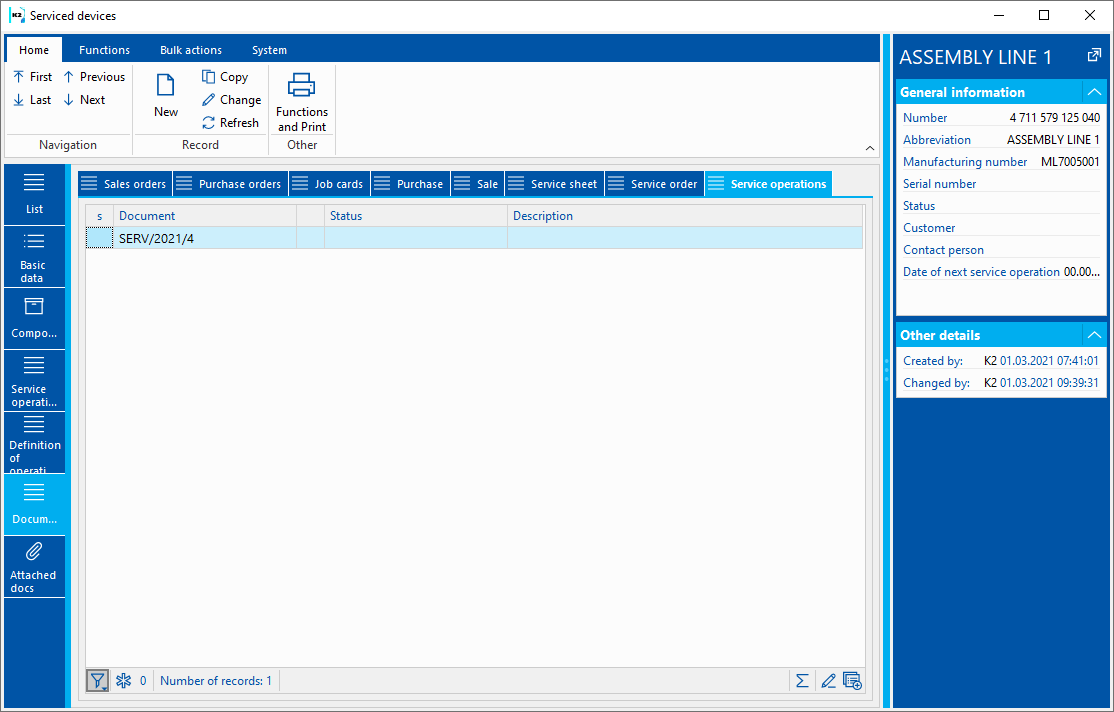
Picture: Example of documents connected to the device
Attachments (6. page) - Serviced equipments
The classic side of attachments, which is used to store the necessary attachments, directly to a specific serviced device. It is also possible to attach a Contract to the serviced device.
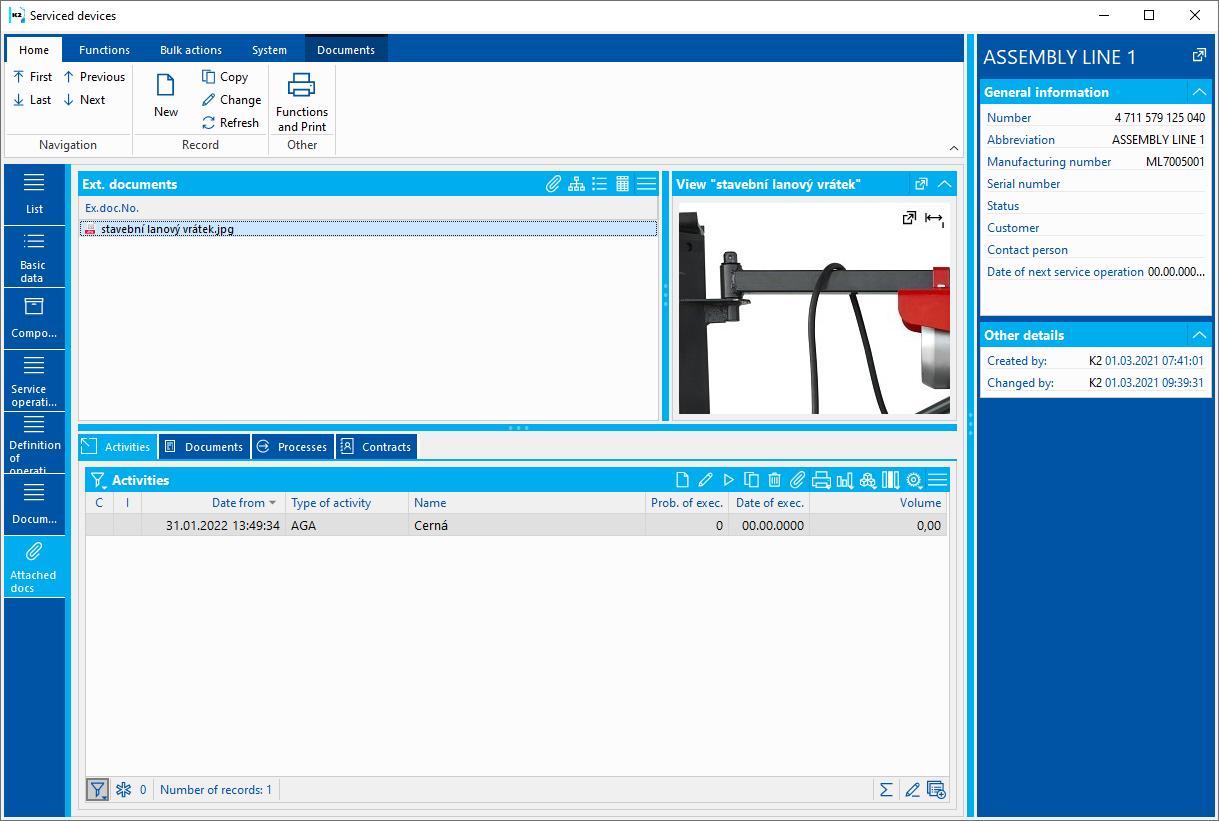
Picture Attachments page - possibility to add a contract
Scheduled service tasks
The Maintenance module includes Scheduled Service Tasks. These actions can be generated from serviced devices using a definition-based command, or inserted manually using the Insert button. The purpose of this book is to keep a simple record of all scheduled tasks.
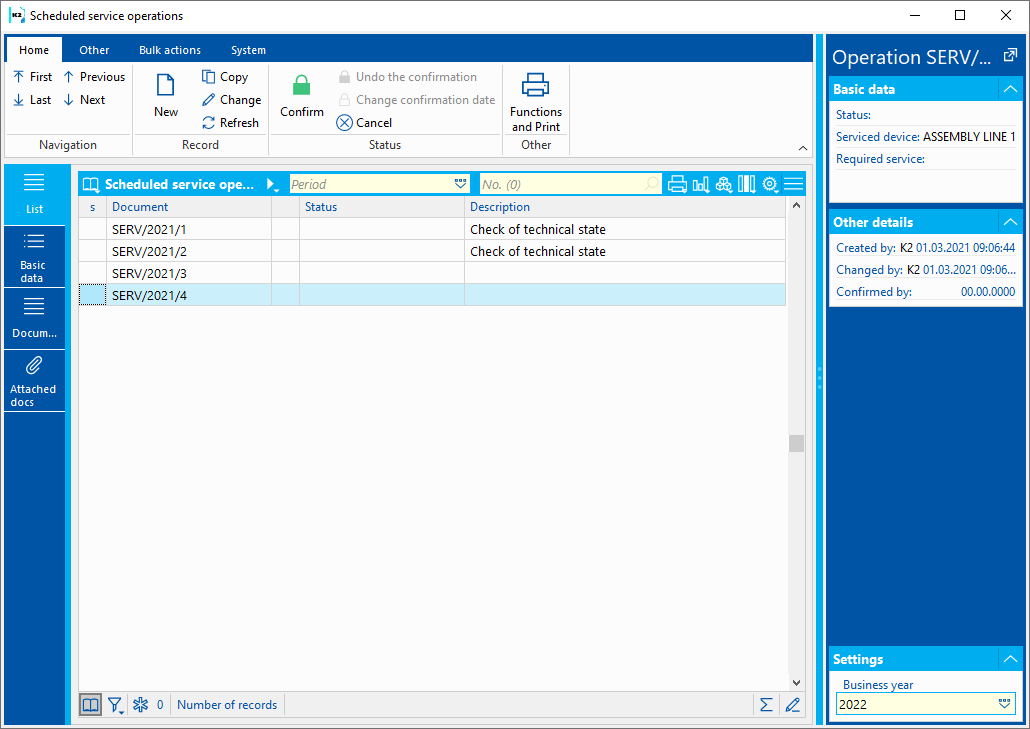
Picture: Scheduled service tasks
Basic data (1st page) - Scheduled service tasks
The basic information about the Scheduled service tasks is sorted as follows:

Picture: Scheduled service tasks
The planned service operation can be understood as a basis for the execution and subsequent registration of actual data from the service operation. Therefore, the time data are divided into Plan and Reality.
Fields' description:
Document |
Scheduled service tasks document |
Serviced device |
Device for which this document of planned service is created. |
Requested service |
Evidence of the service request document - superior document |
Status |
Status of a document. The field can be filled in by a value from the user-defined code list. |
Generated record |
Field indicating the generated record from K2 based on service definitions. |
Description |
Description of the task |
Codes |
Analytical codes |
Time unit |
Specifies the time unit of the action |
Time of task |
Scheduled/real action time in the selected time unit. |
Start date |
Scheduled / actual service start date. |
Start time |
Scheduled / actual service start time. |
End date |
Autofil: Task start + Task time |
End time |
Autofil:l Task start + Task time |
Employees |
Table of assigned employees for a specific service operation. |
Detail description of task |
Detail description of scheduled task When creating from the request, the text is automatically taken over and supplemented according to the completed description on the request of the service action. |
Attributes |
Possibility to select a set of attributes and change individual attributes measured during the service operation. |
Documents (2. page) - Scheduled service tasks
It is a summary of individual subordinate documents that are in the tree of a specific planned action.
Classically, it is also possible to register attachments to a specific act.
Calendars
Using new calendars, you can easily predefine calendars for your technicians and their scheduled service tasks. By clicking, your technicians can get from the calendar to a specific service action to be performed, they can view the latest interventions, contracts, replaced components, basically any information about the device. Using the K2 web, they can easily obtain this information both in the field and on the road.
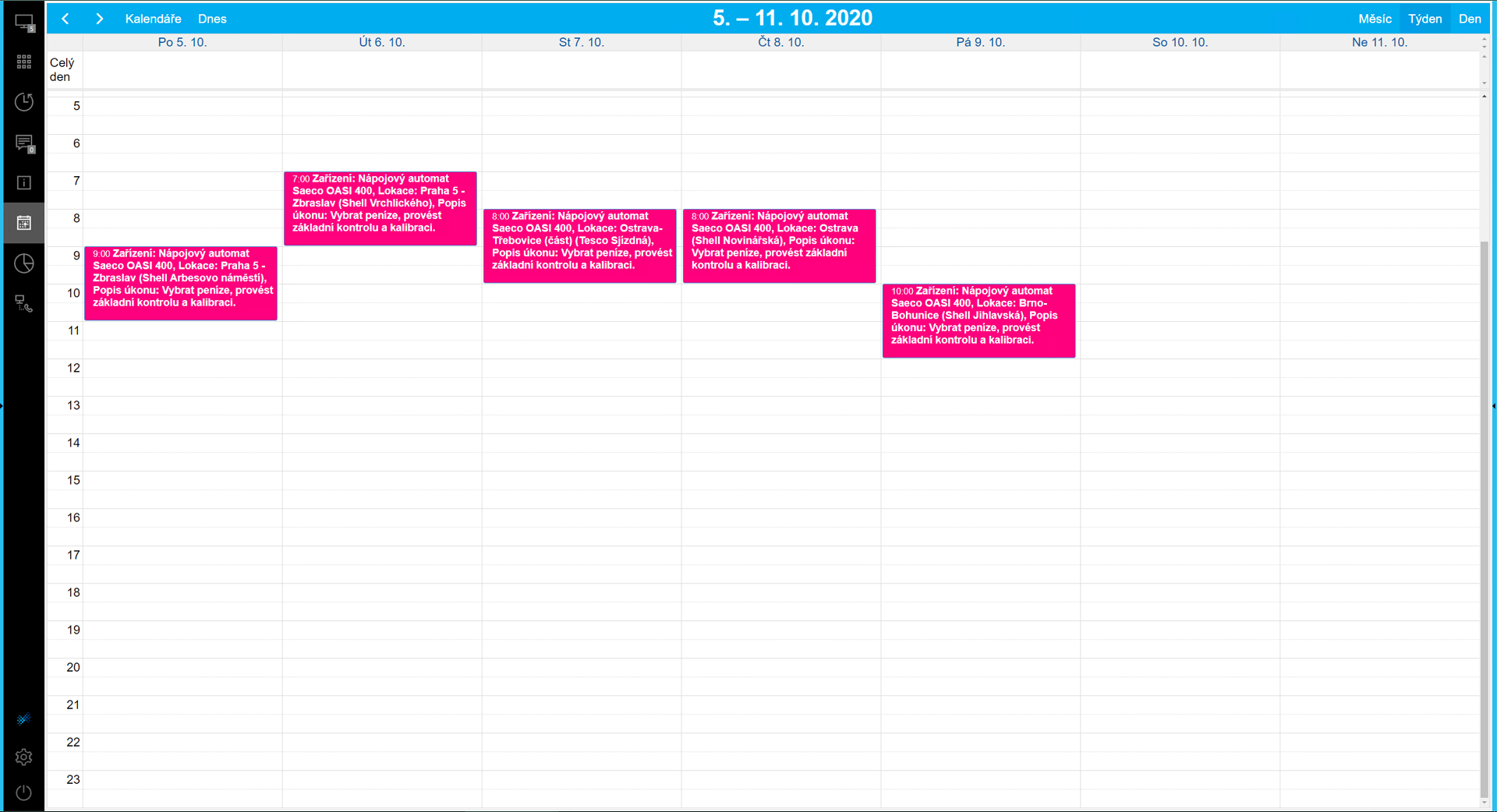
Pict. Example of planned actions in the calendar for a service technician
Service requests
The book contains requirements for servicing a specific device. It is a so-called collection point for all service requirements. The service request may arise directly from the operation.
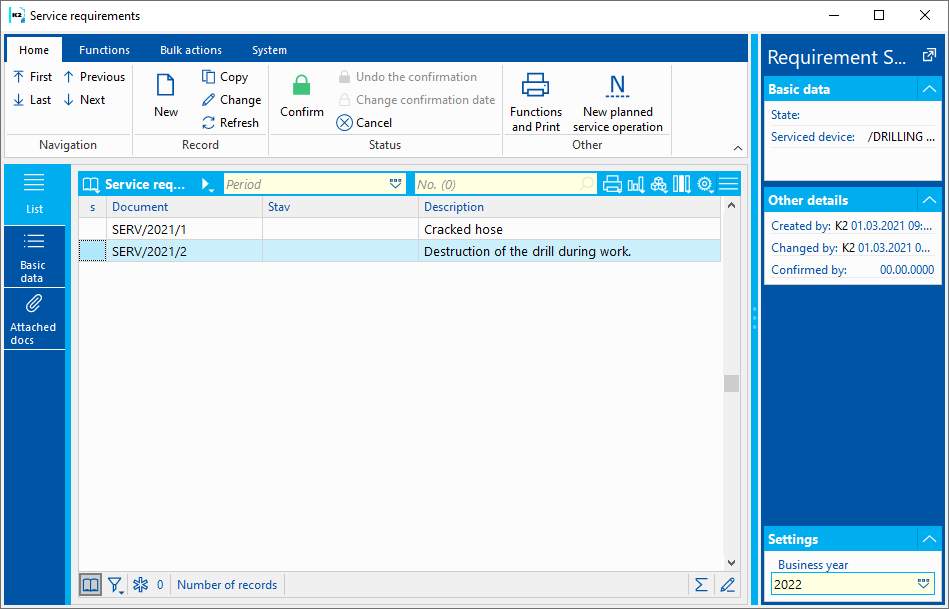
Picture: Service requests
Basic data (1st page) - Service requests
The basic information about the request is sorted as follows:
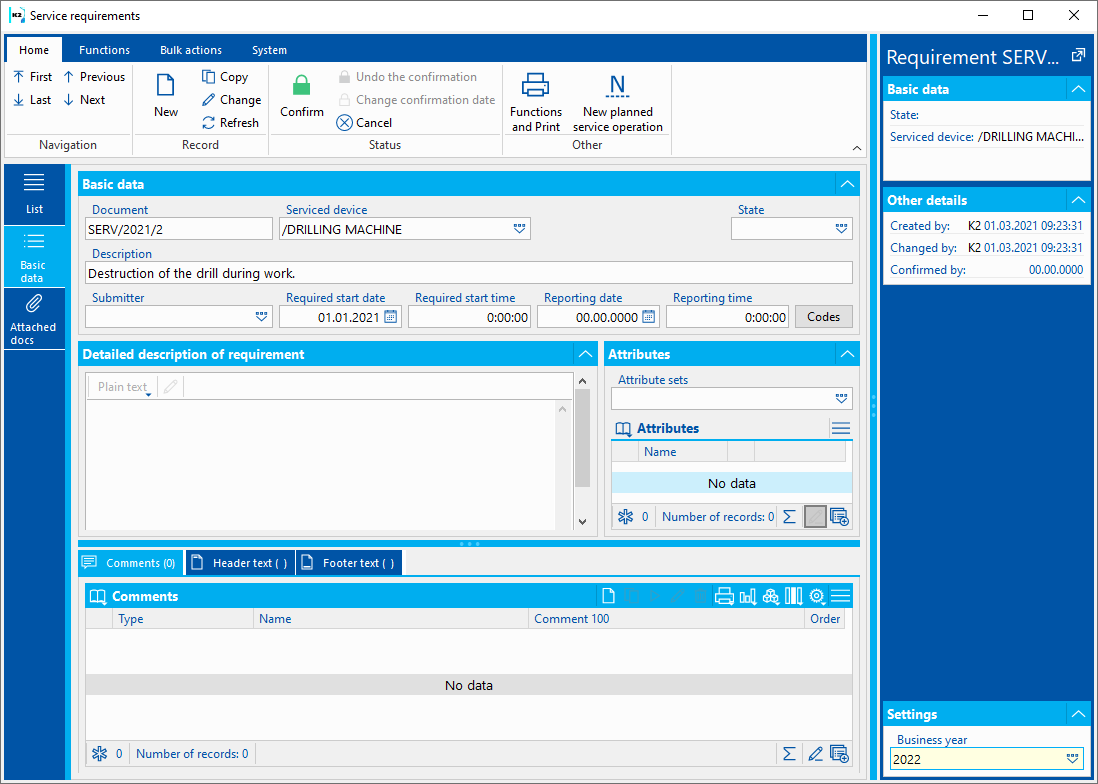
Picture: Service requests
Fields' description:
Document |
Document of Service request |
Serviced device |
Device for which this document of planned service is created. |
Status |
Status of a document. The field can be filled in by a value from the user-defined code list. |
Description |
Description of request |
Submitter |
Submitter of request |
Required start date |
Required date and time of service start |
Required start time |
Required start date of service |
Reporting date |
Date the service request was reported |
Reporting time |
Time the service request was reported |
Codes |
Codes |
Description of the action |
Detailed description / assignment of the action / problem |
Attributes |
Ability to select an attribute set and record the attributes measured during service request reporting. |